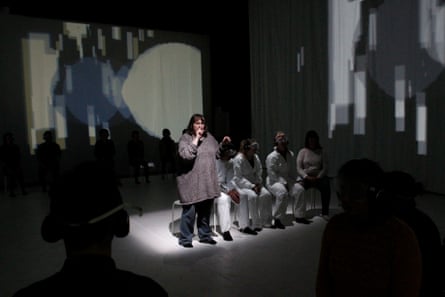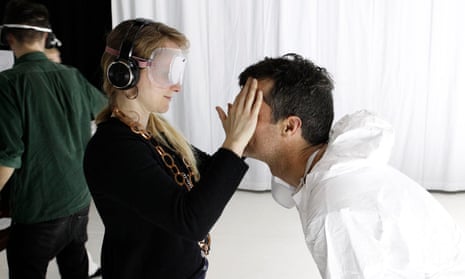Michelle Stevens is both blind and deaf. Yet in her performance Imagined Touch she plays the grand piano, experiencing it not through sound but vibrations. To practise, teachers communicated on her back via social haptics – or the use of touch to talk.
The hour-long show is just one in this year’s Sydney festival that explores the five senses. That includes House of Mirrors – a labyrinth of endless reflections, which plays with ideas of truth – and hit Broadway show The Encounter. In the latter, director Simon McBurney takes the audience into the depths of the Brazilian Amazon, saturated with soggy humidity and the racket of whirring insects, using binaural 3D audio technology.
“In a world [where] we find ourselves living in the digital and the virtual so much, this was a way artists were responding into moving us back into our bodies: through sensory deprivation but also stimulation,” says Sydney festival director Wesley Enoch.
Enoch is tapping into a worldwide movement. Inundated with online information, audiences are seeking more intimate, physical and often collective experiences; many want to be participants rather than simple spectators. Examples range from London’s popular Secret Cinema to the revival of Smellovision, or movies you can smell.
Artists are the canaries down the mineshaft, says Enoch: “We smell things that are dangerous before others do and it’s incumbent on us to talk about it.” Danger, in his eyes, is a deadening of the senses as we spend our lives in front of screens. To combat this, one trend is a growing use of food in art. It asks, “How do we nourish our body in a world where we can easily neglect it?”
For perfumer and artist Cat Jones, one sense we often forsake in our overly sanitised cities is smell. Once our lives were permeated with odours: in 1858, as one extreme example, London endured the “Great Stink”, when heat exacerbated the stench of human waste.
Today, people are largely deprived of smell, both good and bad. “We don’t touch pens and typewriters and all the tools we used to on a daily basis,” says Jones. “All carry their own smell, whereas the smells that come off technology are very limited. In part, it’s about focus, eliminating distraction and overload.”
In Carriageworks’ Scent of Sydney, Jones has interviewed prominent artists, intellectuals and activists on what the city smells like to them, from native frangipani to the stench of cigarette butts, traffic and human sweat. Each discussion has its own scent, sometimes pungent and alive (wet earth after rainfall; tangled roots), at other times repulsive (the sickly sweet whiff of vomit).
Important to Jones is addressing society’s collective anathema towards olfactory matters, or at least those that aren’t packaged up in perfumes or scented household goods.
“In western cultures, smell is taboo,” she says. “Even the act of sniffing is a taboo practice. People never admit that they catch a whiff of each other or even [go so far as to] deliberately smell someone.”
Imagined Touch, likewise, confronts one of our most abiding taboos: feeling another person. Using goggles and headsets, Stevens and her deafblind co-creator Heather Lawson allow the audience into their worlds swamped by darkness. They describe profound isolation but also hope.
“Touch is a way to communication, a way to know you are here, I am here,” Lawson says. In Bali, Lawson fulfilled a lifelong dream to stroke an elephant. The experience was overwhelming: “Touching its ears and the snout. It was raining and muddy and I didn’t care. Touch is the only way I have.”
Director Jodee Mundy herself grew up as the only member of her family who wasn’t deaf: sign language is her first form of communication. She believes it is more egalitarian than the spoken word. “Sign language all comes back to your senses. Whenever you talk, people generally only sign one at a time. When we sign, we usually sign in circles. You don’t turn your back on people. It’s an inclusive culture.”

Using your hands and fingers as the only form of conveying or receiving knowledge can be limiting. But it is also expansive, a liberation from prejudice, insists Mundy. If you’re deafblind “you don’t know if [someone you meet] is a man or a woman, you don’t know if they’re rich or poor, and you don’t even know the colour of their skin”.
The desire to scan and judge others, even subconsciously, is also gone. In its place “the important thing is that a person has a ‘kind hand’,” explains Mundy. “In that sense, Heather and Michelle have a lot to teach us about kindness.”
Food is another way to break down barriers. Hakawati, held at Parramatta’s well-loved El-Phoenician restaurant, is inspired by the Arabic tradition of storytelling and breaking bread (the title translates as “the teller of tales”). As audience members eat, they are regaled with music, dance and spoken vignettes.
The Blacktown production Home Country, set in a multilevel car park and dealing with race and identity, also culminates in a giant feast. On the car park rooftop on a recent sweltering summer night, as thunder broke on the vista beyond, hundreds sat listening to live music and delving into Ethiopian and Middle Eastern delicacies.
Food “creates a certain moment of intimacy among the audience”, explains Julieanne Campbell, general manager of Urban Theatre Project which put on the production with the Blacktown Arts Centre. “Because the work we do is very much about starting a conversation, it gives you space to have that conversation. What have I just seen, who are you, where are you, or let’s just talk about the food.”
The choice of cuisine was deliberate. Blacktown has a strong African and Middle Eastern presence. Soft, tender injera and aromatic Afghani naan bread were chosen due to the way they are consumed: the audience has to delve in, to share, to rip them apart.
Colour was another consideration. “We were very conscious of what the feast looks like on the table,” Campbell says. “It’s about connecting to people – not just on an intellectual level but on a sensory level as well.” It’s also about taking the audience on a journey.
Back in Imagined Touch, Mundy recognises the work is confronting. Then again, it may allow us all to find “a kind hand that is willing to hold you tenderly and take you somewhere”.
